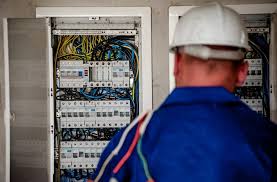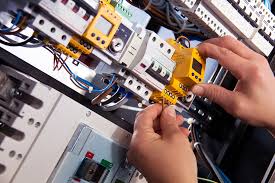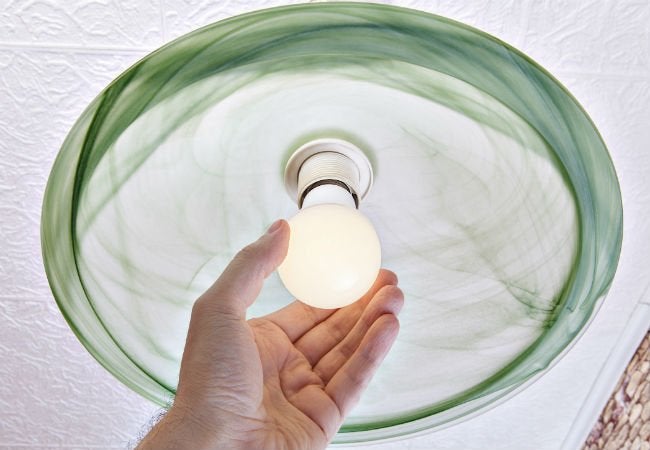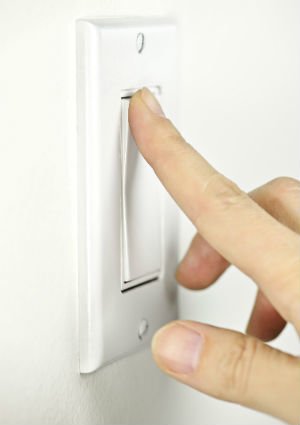Diagnose & fix flickering, dimming lights or lost electricity
A diagnostic catalog of the causes & cures of of dimming light fixtures or flickering lights & power losses.
How to diagnose the causes of flickering or dimming lights at or in buildings.
This article gives simple diagnostic steps that a homeowner can do to determine the type of electrical system problem that is causing flickering or dimming lights or intermittent loss of electrical power. We list the common causes of these problems and suggest what to do about them.
Watch out: flickering or dimming lights often indicates a dangerous condition. Switch off the bad-acting appliance or circuit and ask for help from a licensed electrician
Dimming or Flickering Lights Indicate Electrical Hazards in Buildings: What to Do

Watch out: flickering or dimming lights at a building may be more than an inconvenience. While some causes of flickering lights may be normal and harmless, such as flickering in certain types of light bulbs, many others indicate a dangerous condition, risking fire, shock, injury or worse. The safest approach is to turn off electrical circuits or components that are causing flickering or dimming or acting strangely in any way.
If you cannot safely access your electrical panel to turn off dangerous circuits or components, leave the building and call your local emergency services.
Photo: a fluorescent light fixture may be the only electrical device that is flickering, for any of several reasons we will explain below. Other causes of flickering lights are very dangerous.
Six Tips for Diagnosing Dimming or Flickering Lights at Buildings
In diagnosing the cause of flickering or dimming lights at a building the following diagnostic questions can help narrow down the cause of the trouble.
- Is the dimming light or power loss problem happening in just your building or do neighbors see the same problem at exactly the same time?
If your neighbors are seeing flickering or dimming lights too, chances are the problem is in the electrical supply network or possibly at local electrical wiring in your neighborhood or its power transformer. If your neighborhood frequently loses electrical power

- Is the dimming problem or power loss showing up in the whole building or just parts of it? If all lights in the building dim, flicker, or if all power is lost, then the problem is probably in the electrical panel or at the service entry cabling to your building.
The electrician will look for a problem in the electrical panel, at the main breaker, at the service entry wiring connections or at the SEC wiring itself, including the two hot wires and the service neutral wire. But see the exception in step 4 below.
If the dimming, flickering, or lost power occurs in multiple circuits in the building the problem could still be in the electrical panel itself, or in the service entry wiring to the building.

- Is the dimming or flickering light problem or power loss associated with circuits in just half of the electrical panel? Depending on electrical panel layout, damage to one panel bus can cause failures or odd behaviour on electrical circuits connected to that panel bus.

- Is the dimming light problem or power loss associated with the operation of a single, specific appliance or motor? This is an exception to the case described in step 2 in that all lights may dim when there is a developing failure in a single major appliance such as an air conditioner compressor motor.
Such motors can draw very high amps (current) for just a brief moment when the motor is starting.
If the current surge is very brief, no circuit breaker may trip but the load may be sufficient to dim all of the incandescent lights that are on or all of fixtures in just part of the building, depending on how the appliance circuit is wired in the electrical panel. (Fluorescent lights probably won’t dim).
If the problem never occurs when the circuit to that appliance has been turned off you’ve probably found the trouble.
If the problem is traced to a specific appliance but is intermittent, other variations in conditions such as temperature, humidity, vibration, or moving around of a loose wire may explain that inconsistency.
- Is the dimming or flickering light or power loss showing up on just a single circuit? In this case we suspect a faulty circuit breaker or bad connection in the circuit.
Some circuit breaker brands are particularly prone to failure such as FPE Stab-Lok and Zinsco-Sylvania. In this case the problem may ultimately show up on additional circuits in the same building, depending on building age and circuit usage levels and other conditions.
- Is the dimming or flickering light or power loss showing up just at some fixtures or appliances? A likely cause of this problem is a failing appliance or motor that is drawing abnormally high current as we cited in step 3.
But sometimes the problem may occur only at lights or appliances plugged-in electrically “downstream” from a specific electrical circuit, or at lights operated by a specific switch. In this case we suspect the trouble is not the appliance itself but in connectors within the receptacle or switch or immediately “upstream” (electrically) from it.
Some receptacle and switch types such as older push-in back-wired devices are more likely to have loose or failing electrical connectors with age and usage.
Try plugging in the light fixture or appliance at a different location on a different electrical circuit in the home. If the bad behavior continues then the trouble is in the light or appliance itself.
- Is the flickering light showing up at just one light fixture? Look for loose wiring or an overheating fixture.

- Is the flickering light found in a fluorescent fixture?
If so, while checking for a loose wire or poor fluorescent bulb connection is important, the most common causes of flickering fluorescent light fixtures are
- A bad fluorescent light bulb – take a bulb from a fixture working properly and test it in the flickering fixture; also look for black or other discoloration in the flickering bulb. Replace it.
- A bad starter in the fixture
- A bad ballast in the fixture
In the photo above I am showing the original data tag for this Fox Co. fluorescent fixture installed in the bathroom of a Minnesota home built in 1963.
To stop the flickering light in this luminaire fixture I needed to replace the ballast.
Details of repairing dead, humming, dim, or flickering fluorescent lights are at FLUORESCENT LIGHT REPAIRS.
Watch out: for flickering light safety hazards and take the immediate safety measures listed here.
18 Causes of Dimming or Flickering Lights or Electrical Power Loss at Buildings

Start by turning off any electrical appliance or circuit that is misbehaving. If you are not trained and familiar with safe electrical practices and repairs keep your fingers off of the wiring – you could be shocked or killed or could cause a fire. Call for help from a licensed electrician.
- Aluminum electrical wiring: if your building’s branch circuit wiring (such as lights or electrical receptacles) was installed in the 1970’s solid-conductor aluminum wiring may have been used. With age, use, and mechanical disturbance the connectors in an aluminum-wired circuit become unsafe, ultimately overheating.
These connections can become hot enough to start a building fire without ever tripping a circuit breaker or blowing a fuse. We have had reports from homeowners of both conventional buildings and mobile homes or doublewides who described flickering lights that indicated trouble traced to aluminum electrical wiring.
Watch out: for this fire hazard. If your home’s branch circuits (receptacles and lighting) are wired with aluminum wire, flickering, dimming lights or even sparking may show up on just one circuit but the hazard is building-wide and significant. Turn off the misbehaving circuit and have the electrical system inspected and repaired by an electrician familiar with the hazards of and proper repairs for aluminum wiring. - Appliance or motor drawing high current: Any appliance that draws high current (amperage). Sometimes this is normal such as a brief high current draw when some large electric motors start, such as an air conditioning or heat pump compressor.
An air conditioner or heat pump compressor motor may draw considerably higher amps at start-up than it does once the motor has begun to run.
That’s why installers should use a slow-blow fuse or slow-trip circuit breaker and it’s why air conditioning circuit over-current protection (“breaker size” or “fuse size”) is typically permitted to be one size larger (more amps) than the rating of the wire supplying the circuit.
For example, an air conditioner may run on a #10 copper wire 30 Amp circuit but may be fused with a 35A or 40A circuit breaker to avoid nuisance tripping when the A/C unit is starting normally.
But dimming lights can also mean that a motor is drawing high current because it is having difficulty starting.
That in turn can be due to a motor that is seizing or due to a failing start-capacitor. Some of these conditions are unsafe. If the motor or appliance trips a circuit breaker, leave that appliance turned off until it can be repaired or replaced.
the maximum circuit ampacity (for example 15A) that must be supported by the actual wiring – this is the current drawn when the motor is running
and
the maximum overcurrent protection (for example 20A) that is permitted on the circuit. Typically the data tag will also specify that the installer should use a time delay fuse or HVAC type circuit breaker.
Watch out: many air conditioning and heat pump units are wired with multi-strand aluminum electrical wire – a perfectly legal choice.
But because there is a higher risk of corrosion, resistance, and overheating at the connections of aluminum wiring, if your A/C or heat pump unit is causing severe light dimming or light flickering it makes sense to ask your electrician to check the condition of the wiring and its connections – that will reduce the risk of a total failure or worse, a fire.
Watch out: When you can trace flickering or dimming lights to a single appliance, un-plug it and stop using it until it can be inspected and repaired. If the appliance is a unit such as central air or a heat pump, switch it off at the electrical panel. - Corrosion from unanticipated sources: homes where Chinese drywall was installed were reported to have strange electrical problems including flickering lights. Off gassing from Chinese drywall was found to cause corrosion of copper components throughout some of these buildings, including HVAC components, cooling coils, and copper electrical wiring or connectors.
- Electrical circuit breaker defects: some brands or models of circuit breaker are known to have significantly-higher failure rates than that equipment in general. Examples include Federal Pacific Electric Stab-Lok circuit breakers and ZInsco circuit breakers.
Watch out: fire or shock hazard: When you trace flickering or dimming lights to a specific electrical circuit, turn that circuit off at the electrical panel until your electrician can inspect and repair the problem. - Electrical circuit wiring defects: specific electrical circuits may be dimming or intermittently losing power if the wiring has become damaged or its electrical connectors are loose. Typically this problem shows up first on just one electrical circuit, or on all of the lights or receptacles (“wall plugs or outlets”) downstream from a specific point (where a problem has occurred). A double-wide homeowner reported loss of lights on just one side of a room.
After confirming that no GFCI device had tripped causing a power loss and no circuit breaker had tripped, the owner needed to ask for help from an electrician to find the open wire. For examples - Electric fan or LED bulb induced “light flicker”: when certain fluorescent or LED lights or in particular when an overhead fan is in use, depending on factors such as the location light sources and fan in the room, fan speed, fan blade size and who knows what else can cause an apparent flickering of light where the fan is located.
This is not an electrical problem but one of light and shadow. However depending on the flickering light speed, this condition can be uncomfortable for some people and may be hazardous for some who have particular medical concerns such as light-sensitive epilepsy. Video games and TV’s can also produce flickering light that can be a problem for the same occupants. - Electric motor defects: motors drawing high or excessive current can cause dimming or flickering lights
- Electrical panel defects: as we cite for circuit breakers, some electrical panel brands experience failures far more often than is generally the case among their peers, often because of innate design or manufacturing problems. Some of these electrical panel defects show up as flickering lights, dimming lights, or loss of power on one or more electrical circuits.
- Electrical service supply defects & voltage fluctuations: depending on where you live weather, loads on the community electrical system, age and condition of the electrical grid and power generation can cause dimming or flickering lights. If this is the source of trouble at your building, your neighbors will see the same conditions as you.
Sometimes we monitor voltage being delivered to a building to check the range of voltage variation but of course if your electric company’s supply is varying significantly you and your neighbors will all see dimming lights or total loss of power. Problems at a local power transformer can cause the lights of your home and those of your neighbors to flicker or dim or go out entirely.
Some light flickering, outages that last 60 seconds or less, are referred to in the power industry as “momentary outages” while voltage drops – not a total loss of power but a reduction in the voltage being delivered to a building are referred to as “voltage drops”.
According to Florida Power and Light (FPL), these may be caused by lightning strikes, damaged electrical equipment, animals interfering with electrical equipment (including a mouse in your electrical panel), and in coastal areas, salt spray that affects power company equipment or wiring. - Electrical service connection failure: a loose connection at the building’s electrical service entry cable or damage to the service entry wiring itself can cause flickering lights or loss of power. I’ve seen this problem occur in one side of a 240V electrical panel, causing ultimate loss of power to half of the electrical circuits in the home.
- Electrical neutral connection failure: if the electrical system’s neutral connection or neutral wiring is faulty, such as a loose connection in the electrical panel, lights in the building may periodically flicker or dim or power may even be lost intermittently.
- Fluorescent light ballast & bulb problems: fluorescent lights that use a ballast to produce the voltage needed to drive the light fixture may suffer from a ballast failure. The ballast, a “black box” found inside of fluorescent light fixtures may cause humming or buzzing sounds heard near the light fixture as well as flickering lights.
- Lightning strikes can damage both area electrical wiring or the supply grid as well as damaging components at an individual building. A frequent sufferer of lighting strikes are well pumps and well pump wiring at properties where a submersible well pump is in a steel-casing well in an area subject to frequent lightning storms.
In this case the problem is usually confined to the well circuit, but I have participated in investigation of more extreme damage to all of a building’s wiring and even plumbing systems due to lightning strikes. - Light fixture or light bulb defects: flickering lights that occur only at a single light fixture may be caused by a failing or defective light bulb, particularly if the bulb is a traditional incandescent type.
As the filament in an incandescent light bulb begins to fail it may become loose and intermittently “open” electrically causing the light to flicker. Tapping gently on such a bulb may cause it to go out completely. Changing the bulb should fix the trouble.
If the individual light fixture continues to flicker after a new bulb has been installed, check that the bulb itself is ok by trying it in a different light fixture.
If the light bulb is not defective then I suspect a bad bulb socket in the light fixture or a loose wire connection in the light fixture’s connection to its power circuit. Turn the fixture off until it can be repaired or replaced.
- Loose electrical connections in an electrical circuit: loose splices or connections anywhere in an electrical circuit can cause flickering lights. Usually this defect shows up just on the circuit that contains the faulty connection. I’ve seen this problem at an electrical receptacle that received very frequent use: devices were constantly plugged-in then removed.
The wiggling and jiggling of the device loosened contacts intended to be made between the receptacle and the wall plug. Other receptacles or switches may be wiggled around in their electrical box (if poorly-secured) causing loose, failing electrical connections. - Low or varying voltage from the electrical service utility or due to defects in the service drop or service entry wiring.
- Outdoor electrical wiring defects: aside from the service entry cable problems I’ve cited, other outdoor wiring defects can cause flickering lights on those circuits. Examples include lighting fixtures or receptacles that have become wet.
- Something else is wrong: the list above is certainly not exhaustive and there may be other causes of flickering or dimming lights that we should add here. Please use the page bottom CONTACT link to let us know what we’ve missed.
Watch out: flickering or dimming lights may, depending on the cause, indicate a dangerous condition. Arcing or overheating at electrical circuits can ultimately lead not only to power loss but to a building fire. That’s why we recommend turning off misbehaving electrical equipment while you wait for the electrician.
What Level of Flickering Light Can People See?
Canada’s CCOHS has written some of the most easily-understood description of who sees flickering lights, what people can see or sense, and what health effects may occur when exposed to flickering light. Excerpts are below:
People can see lights flashing on and off up to about 50 flashes per second (50 Hz) – they are most sensitive to time-varying illumination in the 10-25 Hz range. The actual critical flicker frequency increases as the light intensity increases up to a maximum value, after which it starts to decrease.
When a light is flickering at a frequency greater than 50 or so Hertz, most people can no longer distinguish between the individual flickers. At this frequency – the critical flicker frequency or flicker fusion threshold – the flashes appear to fuse into a steady, continuous source of light. This happens because the response to the light stimulus lasts longer than the flash itself.
Most people cannot notice the flicker in fluorescent lights that have a flicker rate of 120 cycles per second (or 120 Hz).
The light flicker may be detected by its stroboscopic effect. When objects move or rotate rapidly, they may be lit at or about the same position during each cycle or rotation.
This makes objects look as if they are moving more slowly than their actual speeds – they may even appear stationary if the object is moving at the same rate as the flicker frequency (or a multiple of it).
This fact is the principle behind a strobe light but it is not the desired effect in general lighting. In fact, it could be a safety hazard if someone mistakenly thought that some equipment was stationary or was moving slowly. – CCOHS, “Lighting Ergonomics – Light Flicker”, Canadian Centre for Occupational Health and Safety, CCOHS, retrieved 2015/11/09, original source: http://www.ccohs.ca/oshanswers/ergonomics/lighting_flicker.html
Also, from a different source we see that flickering light can be a source of eye strain and headaches even if it is not related to electrical malfunctions that we listed earlier in this article:
… the use of high frequency electronic ballasts (20,000 Hz or higher) in fluorescent lights resulted in more than a 50% drop in complaints of eye strain and headaches.
There tended to be fewer complaints of headaches among workers on higher floors compared to those closer to ground level; that is, workers exposed to more natural light experienced fewer health effects.
Solved! What to Do About Flickering Lights
If you’re frustrated by flickering lights, you’re not alone. Read the following response to a question posed by a reader with the same concern.

Q: Help! The light bulbs in our fixtures keep flickering on and off. As far as I know, my house isn’t haunted, but I’m spooked that this could cause a fire. Am I being overly cautious, or do I need to call an electrician?
A: It appears you’re having a “lightbulb” moment. Unfortunately, it’s not the kind that sparks a brilliant idea, but rather, a problem that requires an immediate repair. Short of festive holiday lights or decorative faux candles, a flickering light in a standard fixture is not normal. Although electrical problems should always be taken seriously, you can discern the quick fixes from the causes for concern with these helpful tips.

Start at the source—of the bulb, that is.
- Fluorescent bulbs have a propensity to flicker frequently, due to a variety of everyday factors, including cold temperatures, the bulb burning out while in the socket (tip: replace the tubes to stop this from happening), and the general way that phosphors power up their maximum level. If your fluorescents flicker every now and again, it’s probably not a huge concern.
- For LED bulbs, the most common cause of flickering relates to dimmer switches. These dimmers are manufactured to handle higher electrical loads that don’t always coincide with the lower voltages of LEDs. Before swapping out your standard light bulbs, take an inventory of your existing dimmer make and model, and then cross-check the compatibility to ensure everything will work seamlessly.
Sometimes the solution is as simple as a quick “righty-tighty.”
How many homeowners does it take to screw in a light bulb? The answer is one, but that one person needs to screw it in correctly to avoid any flickering. The solution could be as simple as twisting the bulb so that it sits tightly enough into the socket to make the necessary connection.
A faulty fixture switch or a lose light plug can also cause difficulties.
It’s all about the connections: A loose one between the on/off switch on your lamp or light fixture and the light bulb itself could be the culprit. Wiggle the switch gently to see if it evokes a flicker; if yes, simply replace it to stop the strobe light effect. The issue could also arise from a loose connection between the plug and the outlet. Unplug your lamp, adjust the metal prongs, and then plug it back in. If that does the trick, it may be that the two just needed a more secure fit.
Infrequent shakiness might mean your large appliances are to blame.
Pay attention to the patterns: If you notice your lights flicker consistently when large appliances such as your air conditioner are running, the problem could be that your overall voltage is fluctuating too often, or that you have too much sensory overload on the same circuit. Although slight fluctuations are normal, your home should register between 115 and 125 volts. Purchase a voltmeter online (view example on Amazon) or at your local hardware store to gauge your home’s output, or hire an electrician to take a look.
Loose or outdated wiring is one of the leading causes of house fires. If you try the above troubleshooting techniques and your lights still flicker, this could be a sign of loose service conductors in your main electrical panel, an outdated breaker box with worn connectors, or a switch failure. In any event, whether it’s a system-wide problem or confined to one location, these problems can quickly turn into a fire hazard; call an electrician to pinpoint the problem.
And don’t forget about the neighbors.
Your home shares a transformer with surrounding homes, so a cause of flickering lights may be your neighbors’ heavy electrical usage, or damage caused by downed trees or power lines. An electrician (and a little patience to see if the problem resolves itself!) is your best bet for identifying, locating, and repairing the issue.
